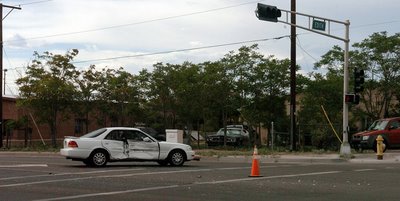 I came upon this scene of a hit and run accident at Edith Blvd. and Odelia Rd. N.E. at 5 p.m. on Sunday, July 23. The car was westbound on Odelia and was struck by a southbound vehicle that ran the red light on Edith. A single orange traffic cone was in the middle of the road east of the car.
I came upon this scene of a hit and run accident at Edith Blvd. and Odelia Rd. N.E. at 5 p.m. on Sunday, July 23. The car was westbound on Odelia and was struck by a southbound vehicle that ran the red light on Edith. A single orange traffic cone was in the middle of the road east of the car.The white car, with the right two doors crushed in, appeared to have no one in it, but, the driver’s door was open. It blocked two lanes of traffic.
I went into “cop mode.”
I looked for the second car, but it wasn’t there.
I had my cellular phone out and dialed 911.
I got a recording putting me into a queue. It is better than years before when the phone would continue to ring and ring and ring. At least it didn’t have elevator music playing. I waited only a few seconds for 911-Operator 63 to come on the line.
I walked into the intersection and looked in the car. The keys were gone and there was no blood or sign of injury. There were post collision skid marks but no skids leading up to the point of impact.
I told 911 that I was at the intersection and she interrupted me saying it was probably an accident. I noticed a minivan parked off the road on the northwest corner with two women in it. I approached and found the driver and her adult daughter, who had come to pick her up.
I asked if the driver was injured. Answer, no. Wrong answer. An injury would have gotten an immediate response from police and fire rescue. I didn’t believe her. She was putting on a good front. However, she appeared to me that she may have actually been injured, but she would only admit to shakiness.
The operator told me that there were no officers available. The daughter said the accident happened more than an hour earlier, just before four and at least four calls had been made.
I ratcheted up my cop mode. I used my name and said that I was a retired officer. I told the operator that the damaged car was a traffic hazard and needed to be dealt with.
“ No units available.” But over an hour wait?
“This is unacceptable,” I took it up another notch. “Who is the sergeant?”
I was placed on hold. About a minute later the operator came back and said the dispatcher had told her that this call was the next one to be dispatched. She asked if I wanted to talk to the dispatcher. I said no, not if the call was the next to be dispatched.
Success, but at what cost? How many calls were jumped because I knew how to play the game?
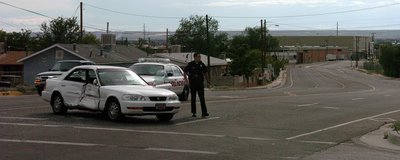 It was almost another half-hour, 5:27 p.m. before an Albuquerque Police car turned off Broadway towards the intersection.
It was almost another half-hour, 5:27 p.m. before an Albuquerque Police car turned off Broadway towards the intersection.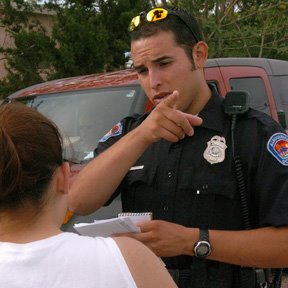 This is Officer J.P. Gallegos, interviewing a quasi-witness, a neighbor who had heard the crash, but did not see what happened leading up to the collision. She offered information about the vehicle that left the scene and gave a description of its driver. She was more than just a good witness, because she had gotten the name and phone number of a witness who had seen the entire incident but wasn’t willing to wait more than an hour and half.
This is Officer J.P. Gallegos, interviewing a quasi-witness, a neighbor who had heard the crash, but did not see what happened leading up to the collision. She offered information about the vehicle that left the scene and gave a description of its driver. She was more than just a good witness, because she had gotten the name and phone number of a witness who had seen the entire incident but wasn’t willing to wait more than an hour and half.The officer, dispatcher and operator all did their jobs appropriately. They approached their duties one call at a time.
Non-injury accidents are not life threatening, requiring an emergency response, but a hit and run accident with a vehicle left in an intersection by a very shaken, middle aged woman poses a traffic problem beyond a minor fender bender. In minor accidents where the participants may pull to the side of the road, they may exchange driver, registration and insurance information and may not even require police intervention. It is the criminal aspect of one driver leaving the scene without identifying themselves that calls for a proper police investigation and pursuit of the offender. The victim of this accident is entitled to prompt service and other motorists should not have to be confronted by wreckage in the roadway.
A man in a pickup truck pulled into his driveway. He asked that I pull my truck deeper onto his property because his elderly mother was returning home and needed all the space she could get.
The man asked about the accident.
He recalled when he was 12-years old; there had been what sounded, “like a bomb.” His father told the children, who were watching television, to stay in the house, while he went out see what happened. The man said, that as kids, we knew all the back ways to the corner, and snuck down to observe that the woman’s car was pushed deep into the Springer warehouse complex parking lot, west of Broadway.
The man shook his head about this hit and run as he drove to his house.
The man was talking about an infamous and horrific accident in Albuquerque’s history. It happened about 35 years ago at Odelia and Broadway, one intersection west.
Doug Lovelady, the son of the local Dodge dealer Wayne Lovelady, got into a high-speed chase driving his new corvette in 1970. Officer Jinx Jones started chasing Lovelady at around Royene and Washington NE. They wended their way east to San Mateo, then to Constitution turning west, proceeding through the four-way stop at Washington and then the signals at Carlisle and Girard. Lovelady turned north on Stanford; Jones didn’t, as he crashed through the fence of the University of New Mexico Golf Course and came to a stop on the 18th fairway.
At Indian School Rd., Lovelady turned west and the chase was taken up by Officer Jim Lehner. They proceeded on Indian School Rd., crossing over Interstate 25 where the road changes names to Odelia. At Broadway, Lovelady broadsided a car at about 100 mph. The crashed killed the woman driver and her young daughter. A horrific scene due to the carnage and infamous, in that Lovelady eventually only served about 90 days in the penitentiary. But that is a story for a different day.
So what’s wrong with this picture?
Mayor Martin Chávez promised to have 1,000 police officers on the force 10 years ago. Where are they?
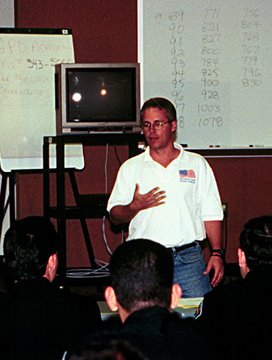 This is Chávez at an illegally held political meeting where Chief Joe Polisar ordered Field Services Officers to attend a city-wide briefing to hear the Mayor extol the virtues of the then proposed quarter cent “Public Safety” tax that the union and I opposed. Polisar wrote the numbers on the board behind Chávez showing the projected growth of the department, reaching 1,000 within two years.
This is Chávez at an illegally held political meeting where Chief Joe Polisar ordered Field Services Officers to attend a city-wide briefing to hear the Mayor extol the virtues of the then proposed quarter cent “Public Safety” tax that the union and I opposed. Polisar wrote the numbers on the board behind Chávez showing the projected growth of the department, reaching 1,000 within two years.The tax proposal died. A couple of years ago a new quarter cent “Public Safety” tax passed, yet the day count, the number of actual officers on the payroll, is still less than 1,000.
So what does this have to do with photo red lights and photo radar?
There is no photo red light camera at the Edith and Odelia intersection. The theory is that having cameras at some intersections changes driving habits, having a carry over affect to other intersections.
Not true this day.
The finding and intent section of the Safe Traffic Operations Program or STOP ordinance declares running red lights and speeding a nuisance and states:
“...City Council finds that the current penalty under state law for running a red light is inadequate to meaningfully address the nuisance and that the City of Albuquerque must implement meaningful civil remedial measures that will stop red light violations and save lives.”
“...City Council finds that state law against school zone violations is inadequate to deter those violations in Albuquerque and that such violations are a nuisance that must be abated by or through civil remedial measures.”
The laws are inadequate?
No, the laws are clear, concise, narrowly directed toward offending drivers and enforceable.
The City of Albuquerque’s Code of Ordinances § 8-2-2-2 Traffic Control Legend.
"Whenever traffic is controlled by traffic control signals exhibiting colored lights or colored lighted arrows, successively one at a time, or in combination, only the colors green, yellow and red shall be used, except for special pedestrian control signals carrying a word legend and the lights indicate and apply to drivers of vehicles and pedestrians.
...(E) Steady Red.
(1) Vehicular traffic facing the signal shall stop before entering the crosswalk, on the near side of the intersection, or if there is no crosswalk, then before entering the intersection shall remain standing until green is shown….
§ 8-2-4-3 Posted Speed Zones.
....(A) No person shall drive a vehicle on a public way at a speed in excess of the lawfully posted speed limit."
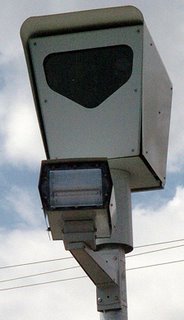 It’s not that the laws are inadequate, but it is the enforcement of the laws that is inadequate.
It’s not that the laws are inadequate, but it is the enforcement of the laws that is inadequate.This is a revenue-generating question versus a manpower management problem.
Deciding to use technology rather than law enforcement personnel is the product of a flawed cost benefit analysis. Assumptions were made without regard for legal rights because a formal analysis was not done.
There are 582 intersections with traffic control light signals in town. Only six intersections have permanently affixed photo red light cameras.
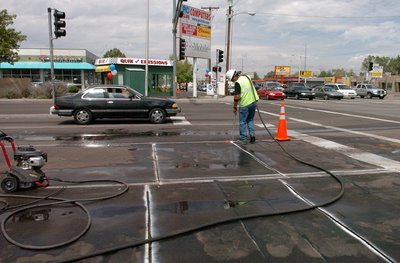 Here, a contractor works on electrical sensors at the photo red light controlled intersection of San Mateo and Menaul N.E.
Here, a contractor works on electrical sensors at the photo red light controlled intersection of San Mateo and Menaul N.E.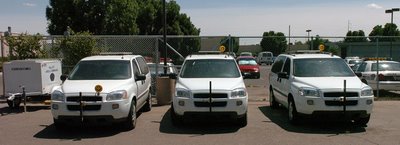 By using cameras with photo red light intersections and photo radar vans and then bypassing the Metropolitan court system, the city can generate a higher percentage of profit from its $100 to $450 fines than they can make through the percentage they receive by using the state’s court systems.
By using cameras with photo red light intersections and photo radar vans and then bypassing the Metropolitan court system, the city can generate a higher percentage of profit from its $100 to $450 fines than they can make through the percentage they receive by using the state’s court systems.The STOP legislation emphasizes that; “The City Council declares that this article is a nuisance abatement article enacted pursuant to the city's inherent authority under state law and that the remedies are purely civil and not criminal in nature.”
This is a legal fiction; a sidestepping of the requirement to use the state’s court systems to adjudicate traffic violation enforcement.
STOP is predicated on violations of the state and city’s traffic laws, but as soon as they cross that legal threshold, all requirements for law enforcement are suspended, rejected and replaced with a unique and novel philosophy.
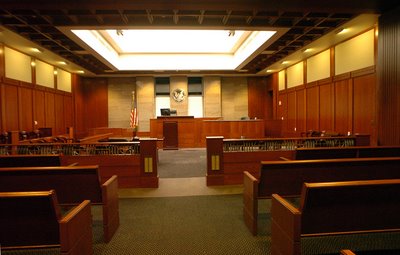 Constitutional guarantees; of separation of powers, the right to have an independent judge, to have a fair trial, to confront witnesses, to cross-examine witnesses, to have the minimum burden that applies to traffic offenses, which is the standard criminal burden of proof, that each and every element of a statutory violation is proven “beyond a reasonable doubt” and the right to appeal to a higher court are abandoned.
Constitutional guarantees; of separation of powers, the right to have an independent judge, to have a fair trial, to confront witnesses, to cross-examine witnesses, to have the minimum burden that applies to traffic offenses, which is the standard criminal burden of proof, that each and every element of a statutory violation is proven “beyond a reasonable doubt” and the right to appeal to a higher court are abandoned.The state retains the judicial power while the city is limited to declaring what a public nuisance is, setting a penalty that does not exceed that of a misdemeanor and it has no other inherent authority under state law to process challenges to the allegations of a violation of any of its city ordinances.
When the city council declared that traffic triggered violations were a nuisance calling for abatement, adjudication in District Court is required. A respondent is entitled to a jury trial in front of a panel of their peers. STOP is an abuse of the legal theory underlying nuisance abatement laws.
By setting up a city administrative hearing officer and by not requiring; a uniformed police officer from personally observing the offense, arresting, through a traffic stop, then issuing a citation and appearing in court to prove the case, the city can save a great deal of money and instead of sharing its profits with the state, it only has to share with the cameras’ vendor.
Municipal governments are not supposed to be a profit making operation. Government is a zero-sum proposition. Government may not spend more than it takes in through taxes, fines and fees.
Officers are given discretion and they may exercise it appropriately. An officer may write a citation that he feels will deal with the problem that may not even address the initial violation that caught his eye.
Society accepts this all the time. Driving while under the influence of narcotics, drugs or alcohol is a prime example. Many DWI drivers are stopped for minor infractions, such as; failure to maintain a traffic lane, or not proceeding immediately when a traffic light changes, or driving well below the speed limit and in some cases simply driving the speed limit while the traffic flow is going faster than the speed limit. All of these examples, absence the DWI, probably would not result in even a ticket. The officer, in exercising discretion, is empowered to talk to the driver and may give a verbal or written warning, if he is satisfied that the driver will heed.
Experienced rational officers do not function as automatons, but have adopted a feeling, thought and theory about when to pursue a driver who entered a controlled intersection late, against a just changed red light. The officer takes at least three things into consideration about the “offending vehicle:” Was the vehicle really late, more than the split second that the photo red light system registers? Did it interfere with the traffic that just received a green light? Was it speeding at the time it entered that intersection?
 Officers do not function in a vacuum, they do not read the traffic code out of context and they are realistic about the concept of defensive driving that requires all drivers to act with due care and caution. As the basic federal rule of aviation requires that pilots shall see and avoid other aircraft. This applies equally to drivers as outlined in the City of Albuquerque’s Code of Ordinances § 8-2-2-2 Traffic Control Legend.
Officers do not function in a vacuum, they do not read the traffic code out of context and they are realistic about the concept of defensive driving that requires all drivers to act with due care and caution. As the basic federal rule of aviation requires that pilots shall see and avoid other aircraft. This applies equally to drivers as outlined in the City of Albuquerque’s Code of Ordinances § 8-2-2-2 Traffic Control Legend.“(F) Red with Green Arrow.
(1) Vehicular traffic facing the signal may cautiously enter the intersection only to make the movement indicated by the arrow, but shall yield the right-of-way to pedestrians lawfully within a crosswalk and to other traffic lawfully using the intersection; and….”
Isaac Newton also proffered the notion in his laws of physics that two objects may not occupy the same space at the same time. It is the duty of every driver to ”cautiously enter the intersection” making sure that they do not test Newton’s laws of physics by driving defensively. As an old axiom goes; you may be right, but dead right and that makes you wrong.
STOP doesn’t recognize the exercise of discretion. Stop is an anvil upon which technologies’ hammer strikes. Horseshoes are made of steel, heated then pounded into shape. Humans are more pliable; logic and reasoning can change their behavior without physical or economic force or violence.
Fines, upon conviction or plea, are designed to alter performance and hold drivers responsible for their individual acts of inappropriate and or illegal behavior. STOP doesn’t target the responsible individual, it declares the vehicle a nuisance and holds the registered owner liable for the actions of the vehicle.
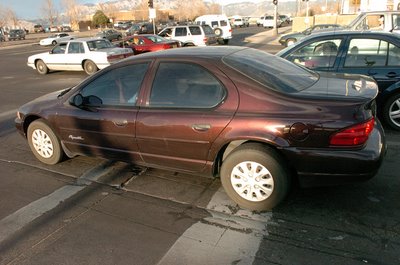 This vehicle, having crossed the thick white "stop line" before the crosswalk at the photo red light enforced intersection of San Mateo and Montgomery N.E., is technically in violation of the law against running a red light. Note the grooves cut into the pavement. The set of grooves from the center of the "stop line" to just before the crosswalk is the sensor, seen here under the rear door. It reads two separate ferrous metal masses, supposedly the front and rear axels, triggering the photo red light camera. This car should not have been sent a notification because the rear axel should not have been sensed, but even if it was, it had not proceeded through the intersection against the red light signal.
This vehicle, having crossed the thick white "stop line" before the crosswalk at the photo red light enforced intersection of San Mateo and Montgomery N.E., is technically in violation of the law against running a red light. Note the grooves cut into the pavement. The set of grooves from the center of the "stop line" to just before the crosswalk is the sensor, seen here under the rear door. It reads two separate ferrous metal masses, supposedly the front and rear axels, triggering the photo red light camera. This car should not have been sent a notification because the rear axel should not have been sensed, but even if it was, it had not proceeded through the intersection against the red light signal.So, do I have a suggested alternative solution?
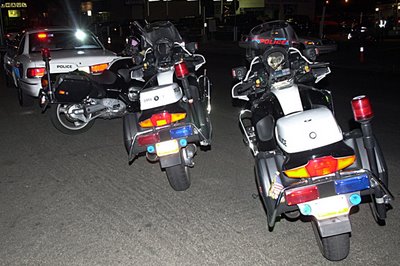 Yes, increase the traffic division to 50 officers.
Yes, increase the traffic division to 50 officers. The Europeans have an approach to traffic control at intersections. Even with traffic lights, they assign one or two officers to busy and problematic intersections.
 Hire thirty retired, "white-stripers," former traffic officers; issue each a motorcycle, assign them their own intersection, or radar zone and give them all the ticket books they can write. Take 15 officers and assign them to handle “their intersection.” Do not assign them to any other duties and let them handle all traffic, including accidents at 15 intersections, as needed. With the remaining 15, create three five-man flying squads, made up of one laser radar unit and five officers who saturate a particular speed zone.
Hire thirty retired, "white-stripers," former traffic officers; issue each a motorcycle, assign them their own intersection, or radar zone and give them all the ticket books they can write. Take 15 officers and assign them to handle “their intersection.” Do not assign them to any other duties and let them handle all traffic, including accidents at 15 intersections, as needed. With the remaining 15, create three five-man flying squads, made up of one laser radar unit and five officers who saturate a particular speed zone.Benefits: additional charges including: no seatbelts; no drivers licenses, suspended or revoked licenses; no proof of insurance; no valid registration; stolen vehicles recovered; felony and misdemeanor warrants through NCIC; DWI arrests….
All of these benefits and more can be identified through the personal contact during traffic arrests and cannot be accomplished through the use of photo red light and photo radar. Officers can be deployed to any intersection or speed area as needed.
The presence of a uniformed motorcycle officer has an immeasurable, yet profound effect on crime.
Specifically, residential burglars can be moved from a neighborhood through the use of traffic enforcement saturation patrols, or “writing everything that moves,” for any and every violation. The photo red light and photo radar technology does not and cannot have such an affect.
Fifteen to 30 additional officers, retired or active, equipped with motorcycles, laser radar units and all the ticket books they can stuff into their saddle bags would cost between one to two million dollars a year. The revenue generated through tickets would be about the same as the current photo red light and photo radar. However, the judicial process would pass constitutional muster. Of course the high revenue, low drag process now in use under the STOP ordinance would produce less money per incident if it had to go through the state’s courts.
Thirty additional officers are already authorized and would help surpass the 1,000 officers “magic” number, as promised.
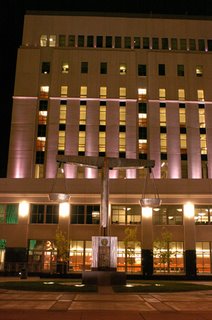 One other thought that arose about the penalty phase of the city’s administrative hearing officer’s options. He has none. Unlike Metropolitan Court, where a first offender is usually offered traffic school, or placed on a deferred sentence, or the case taken under advisement, or the defendant may agree to do community service in lieu of paying a fine, or the fine may be reduced, the hearing officer may only impose the $100 fine. There is no humanity or leniency allowed under STOP. It is arbitrary, imposes strict liability and is oppressive.
One other thought that arose about the penalty phase of the city’s administrative hearing officer’s options. He has none. Unlike Metropolitan Court, where a first offender is usually offered traffic school, or placed on a deferred sentence, or the case taken under advisement, or the defendant may agree to do community service in lieu of paying a fine, or the fine may be reduced, the hearing officer may only impose the $100 fine. There is no humanity or leniency allowed under STOP. It is arbitrary, imposes strict liability and is oppressive. Which raises the question of where does one find justice? Like “Equal Justice Under the Law,” as is found over the doors to the United States Supreme Court.
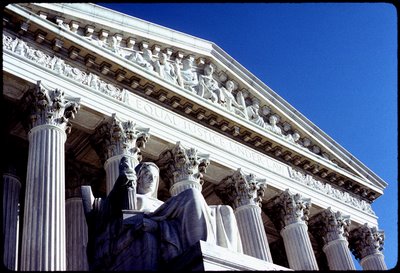
Don’t ask the City of Albuquerque, for they don’t know the meaning….
2 comments:
Great Information. That sounds pretty cool. Really helpful thanks for the Article, Great job, Keep posting interesting matters here. Looking forward to it. Thanks and keep it up! All the Best.
Hard hitting facts but with a dash of humour. More and more people want to share information, as long as we have good controls over that and I think that’s really where the world is going on and thanks for stopping by and sharing some great information.
- Rathod Wilson
Post a Comment